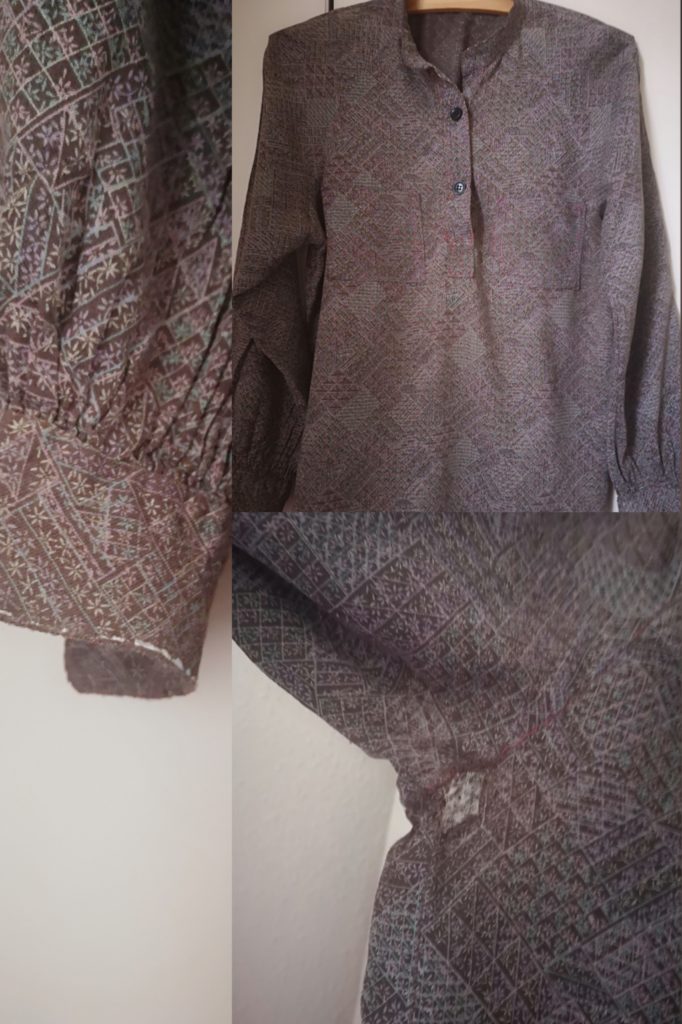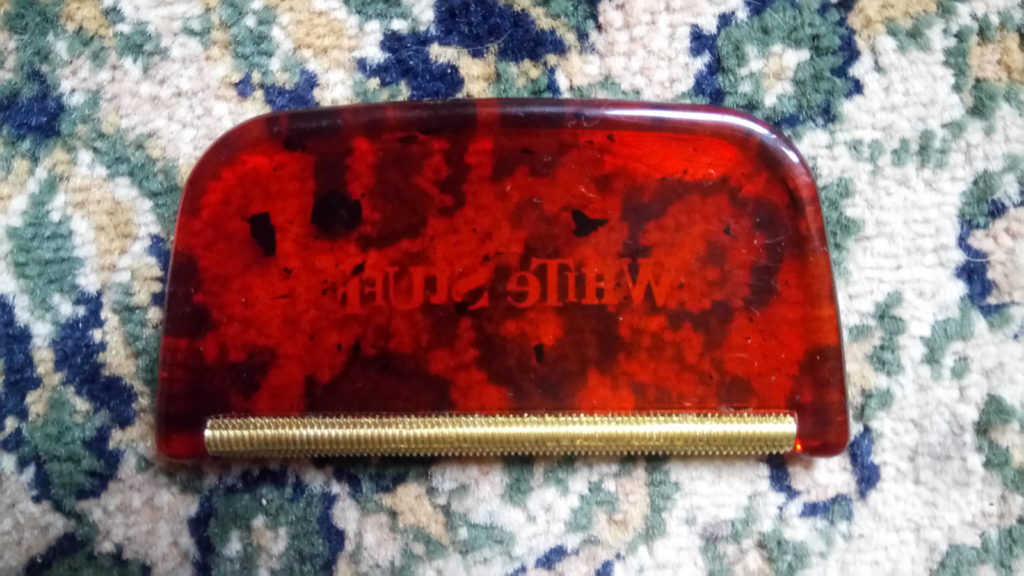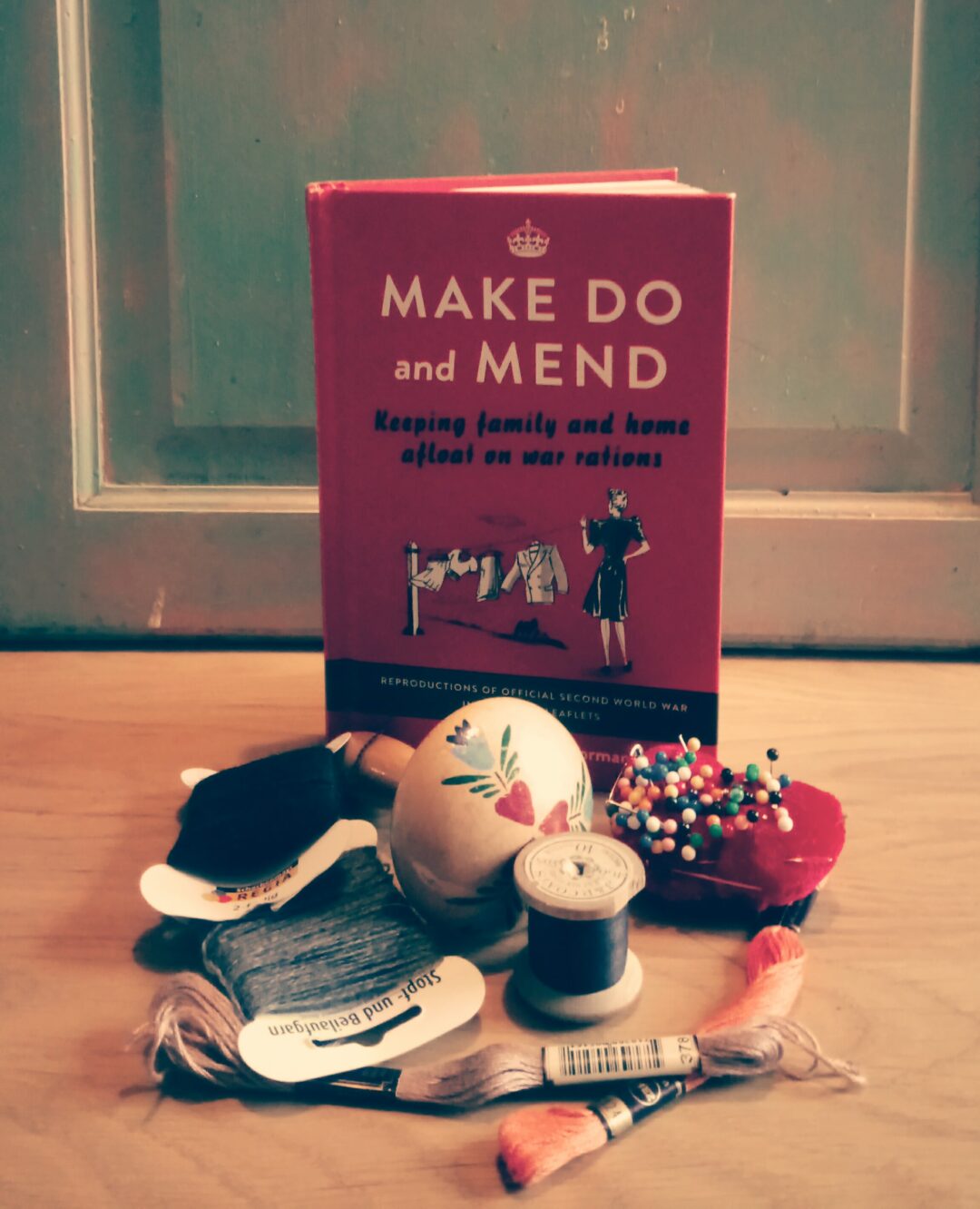Mending has never been my favourite occupation, but I’m learning to appreciate the art more lately. It’s taken me some time to find the motivation to make do and mend. Pledging to buy no new clothes for several more months has brought me here and sharpened my attention on making what I have last longer. I aim to give clothes and accessories a new lease of life, so mending has taken on an a new meaning for me.
Mending is getting a lot of attention too on social media. Hashtags like #makedoandmend, #visblemending, #menditmay have been circulating on Twitter and Instagram, and it’s probably all rolled up with a backlash against fast fashion. Search for #slowfashion too.
I have a mending pile that is rising higher. Socks, winter tights, one fraying silk scarf, the worn cuffs and split seams of an old, but favourite, handmade blouse, and little holes in this and that. I’ve put down the new cardigan I was knitting and turned my mind to it. ‘It’ being the pile that I’ve been squirreling away in a spare room, out of sight, and more-or-less out of mind. The problem has been the starting, but once I’ve started I generally find it more therapeutic than I would have thought. Once I have decided what to mend first and what to mend next.
Finding motivation to make do and mend

Why has starting been difficult? Possibly because it’s often more tempting to make or buy something new. Or, is it because the frayed articles with split seams are less than lovely to look at once they have reached that stage? Both are hard to ignore dis-incentives.
I’m committed to the ‘buy nothing new’ for a while, followed by buying very little after that. Though I’ve fully taken on the reasons why, I have a harder time with suspending making something new.
I like the creative process, the learning of skills and so many aspects of making stuff. So, on the plus side, I’m focussing on using my stash materials for new makes which certainly exercises the creative and resourceful brain cells. At the end of the day though, it’s pointless having perfectly good clothes sitting in a pile, not being used. The creative process and learning of skills that I associate with making new from scratch can also apply to mending. I just haven’t explored it enough yet.
Sort through your mending pile
I need to take time to sort through it and get some rationale. First I need to help with the psychological effects of the less than lovely looking items. Take that old crumpled blouse, iron it, hang it up and snip the frayed cotton thread for now. Decide whether to use visible or invisible mending and visualise the loose stitching replaced. Imagine the worn cuffs and collar patched or replaced in a fabric that compliments. Then it becomes an item of potential. Sort out what to mend first, what might come second and the truly unlovable or unusable.

Mend first pile
On my list of what to mend first are:
- Favourites
- Easy to mend items
- Handmade items in which much time has been invested
- Most needed (would fill a gap in the wardrobe)
What to mend second
I guess these would be the ‘maybe favourites’, the slightly harder to mend and the ‘might be useful’. If you’re a minimalist you will probably discount these anyway.
Bottom of the pile

It’s the ‘hard to find the motivation’ category that I find interesting though. Featuring high are the bobbled and pilled fabrics and knits, which, generally, have synthetic fibres in their mix. These fibres are the most prone to pilling. You can fix that hole but the pills are scattered over the whole garment. You can run a de-pilling comb over it, but you have to keep going in repeat mode.
Those acrylic/wool mixes just don’t look good for long. I much prefer natural fibres and aim to gradually transition to a more natural-fibred wardrobe. Meanwhile I’m looking at the ‘hard to find the motivation’ pile. Annoyingly the phrase ‘there no such thing as away’ passes through my mind.
There is no such thing as away
Go away that phrase – how inconvenient! The first time it seared itself into my mind was when watching the BBC 2 TV series It’s Not Easy Being Green back in 2006. I have the book. Since then news has got around that charity shops are overwhelmed with our donations. Much of it gets sent abroad, creating other problems. Recycling or donating your unwanted clothes ‘is not a solution’ for the planet says Greenpeace. It’s a sobering thought. We need to remember that everything has to go to somewhere. It’s the opposite side of the problem to the fact that everything has to come from somewhere.
Related: Sustainable Life: Everything Has to Come From Somewhere.
What should you do with an unloved pile? Make mends into attractive embellishments and send them to a charity shop in the hope that they will find a second home? I have no answer at present, so my unloved pile of clothes will sit there while I ponder. If you have any suggestions, please comment below.
One solution
I come to black ankle socks, complete with holes. I’ve been very boring with my sock repertoire so I have a few of these. They go very well with dark jeans because if you are on the short side (like I am), socks that merge in with your jeans trick the eye into seeing longer legs than are actually there. The trouble is they are another hard-to-love item. However, as I’m trying not buy new (even socks) I will mend with a creative mend. I’m thinking earthy-coloured darns at the moment.
Sock knitting in pure wool is on the horizon, where I will try to break my black sock habit with something more interesting. When they need darning, I think I will be more easily inspired.
Mending and craftivism
There might another motivation to make do and mend. You could look at mending as a form of ‘craftivism’. That’s activism through crafting. If you’ve come across the word craftivism, it might be because you’ve seen a pop-up exhibition of pieces of artwork or craftwork which has an activist message incorporated into or onto the fabric. My form of craftivism is more functional though. I see visible mending as a form of craftivism because it’s sending out the message that you thoughtfully mended something rather than buying new. Even invisible mending is a quiet little stand against consumerism. I mentioned this is in Craftvism and activism – history repeats itself .
Resources
So, are you motivated to mend? Need some help?
Try Make Do and Mend: Keeping Family and Home Afloat on War Rations, a reprint of a very useful book for invisible mending. Tom of Holland is all about mending, and runs workshops. Search the #tags at the beginning of this post. There’s no end of inspiration to be found. If you aren’t a sewer, you’ll find that a few basic stitches go a long way, and you might also find that it’s the road towards upcycling clothes then making new from scratch.
Coming full circle, once I’ve had a spell of not buying new, then buying me selectively, my wardrobe will be smaller. The quality of materials will be better too. there will be a smaller mending pile of items that age better and mend more attractively.

